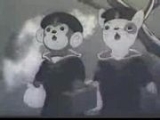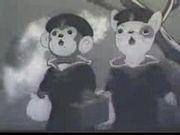
Momotaro's Divine Sea Warriors
Encyclopedia
is the first Japanese feature-length
animated film
. It was directed by Mitsuyo Seo
, who was ordered to make a propaganda film
for the war
by the Japanese Naval Ministry
. Shochiku
Moving Picture Laboratory shot the 74-minute film in 1944 and screened it on April 12, 1945. It is a sequel to Momotarō no Umiwashi, a 37-minute film released in 1943 by the same director. It is black and white.
 After completing naval training, a bear
After completing naval training, a bear
cub, a monkey
, a pheasant
, and a puppy say goodbye to their families. Like the prior film, the movie features the "Peach Boy
" character of Japanese folklore. The film is about the surprise maneuver on Sulawesi
island, depicting parachute troops' actions. The monkey, puppy and bear cub are the ones that become parachute jumpers while the pheasant becomes a pilot. The whole movie also depicts the Japanese "liberation of Asia
", as proclaimed by the Government
at the time.
There are some musical scenes. Of note is , a scene where Japanese soldiers teach local animals how to speak.
, a 1940
Disney
film. Inspired by this, Seo tried to give dreams to children, as well as to instill the hope for peace, just as he did in the prequel movie, Momotaro's Sea Eagles.
is famous for being given a homage in the series by Osamu Tezuka
(Tezuka watched the film in April 1945. He later said that he was moved to tears by the movie's hints of dreams and hopes, hidden under the appearance of war propaganda).
For a long time, the film was presumed to have been confiscated and burnt by the American occupation
. However, a negative copy of the film was found in Shochiku's Ofuna warehouse in 1983 and was re released in 1984. A reproduced movie was later screened and the VHS package is now available in Japan.
Feature film
In the film industry, a feature film is a film production made for initial distribution in theaters and being the main attraction of the screening, rather than a short film screened before it; a full length movie...
animated film
Anime
is the Japanese abbreviated pronunciation of "animation". The definition sometimes changes depending on the context. In English-speaking countries, the term most commonly refers to Japanese animated cartoons....
. It was directed by Mitsuyo Seo
Mitsuyo Seo
was a Japanese animator, screenwriter and director of animated films who played a central role in the development of Japanese anime. He was born in Himeji, Hyōgo Prefecture.-Career:...
, who was ordered to make a propaganda film
Propaganda film
The term propaganda can be defined as the ability to produce and spread fertile messages that, once sown, will germinate in large human cultures.” However, in the 20th century, a “new” propaganda emerged, which revolved around political organizations and their need to communicate messages that...
for the war
World War II
World War II, or the Second World War , was a global conflict lasting from 1939 to 1945, involving most of the world's nations—including all of the great powers—eventually forming two opposing military alliances: the Allies and the Axis...
by the Japanese Naval Ministry
Ministry of the Navy of Japan
The was a cabinet-level ministry in the Empire of Japan charged with the administrative affairs of the Imperial Japanese Navy . It existed from 1872 to 1945.-History:...
. Shochiku
Shochiku
is a Japanese movie studio and production company for kabuki. It also produces and distributes anime films. Its best remembered directors include Yasujirō Ozu, Kenji Mizoguchi, Mikio Naruse, Keisuke Kinoshita and Yōji Yamada...
Moving Picture Laboratory shot the 74-minute film in 1944 and screened it on April 12, 1945. It is a sequel to Momotarō no Umiwashi, a 37-minute film released in 1943 by the same director. It is black and white.
Plot

Bear
Bears are mammals of the family Ursidae. Bears are classified as caniforms, or doglike carnivorans, with the pinnipeds being their closest living relatives. Although there are only eight living species of bear, they are widespread, appearing in a wide variety of habitats throughout the Northern...
cub, a monkey
Monkey
A monkey is a primate, either an Old World monkey or a New World monkey. There are about 260 known living species of monkey. Many are arboreal, although there are species that live primarily on the ground, such as baboons. Monkeys are generally considered to be intelligent. Unlike apes, monkeys...
, a pheasant
Pheasant
Pheasants refer to some members of the Phasianinae subfamily of Phasianidae in the order Galliformes.Pheasants are characterised by strong sexual dimorphism, males being highly ornate with bright colours and adornments such as wattles and long tails. Males are usually larger than females and have...
, and a puppy say goodbye to their families. Like the prior film, the movie features the "Peach Boy
Momotaro
is a popular hero from Japanese folklore. His name literally means Peach Tarō; as Tarō is a common Japanese boy's name, it is often translated as Peach Boy...
" character of Japanese folklore. The film is about the surprise maneuver on Sulawesi
Sulawesi
Sulawesi is one of the four larger Sunda Islands of Indonesia and is situated between Borneo and the Maluku Islands. In Indonesia, only Sumatra, Borneo, and Papua are larger in territory, and only Java and Sumatra have larger Indonesian populations.- Etymology :The Portuguese were the first to...
island, depicting parachute troops' actions. The monkey, puppy and bear cub are the ones that become parachute jumpers while the pheasant becomes a pilot. The whole movie also depicts the Japanese "liberation of Asia
Greater East Asia Co-Prosperity Sphere
The Greater East Asia Co-Prosperity Sphere was a concept created and promulgated during the Shōwa era by the government and military of the Empire of Japan. It represented the desire to create a self-sufficient "bloc of Asian nations led by the Japanese and free of Western powers"...
", as proclaimed by the Government
Empire of Japan
The Empire of Japan is the name of the state of Japan that existed from the Meiji Restoration on 3 January 1868 to the enactment of the post-World War II Constitution of...
at the time.
There are some musical scenes. Of note is , a scene where Japanese soldiers teach local animals how to speak.
Background
The Naval Ministry previously showed Seo FantasiaFantasia (film)
Fantasia is a 1940 American animated film produced by Walt Disney and released by Walt Disney Productions. The third feature in the Walt Disney Animated Classics series, the film consists of eight animated segments set to pieces of classical music conducted by Leopold Stokowski, seven of which are...
, a 1940
1940 in film
The year 1940 in film involved some significant events, including the premieres of the Walt Disney classics Pinocchio and Fantasia.-Events:*February 7 - Walt Disney's animated film Pinocchio is released....
Disney
The Walt Disney Company
The Walt Disney Company is the largest media conglomerate in the world in terms of revenue. Founded on October 16, 1923, by Walt and Roy Disney as the Disney Brothers Cartoon Studio, Walt Disney Productions established itself as a leader in the American animation industry before diversifying into...
film. Inspired by this, Seo tried to give dreams to children, as well as to instill the hope for peace, just as he did in the prequel movie, Momotaro's Sea Eagles.
is famous for being given a homage in the series by Osamu Tezuka
Osamu Tezuka
was a Japanese cartoonist, manga artist, animator, producer, activist and medical doctor, although he never practiced medicine. Born in Osaka Prefecture, he is best known as the creator of Astro Boy, Kimba the White Lion and Black Jack...
(Tezuka watched the film in April 1945. He later said that he was moved to tears by the movie's hints of dreams and hopes, hidden under the appearance of war propaganda).
For a long time, the film was presumed to have been confiscated and burnt by the American occupation
Occupied Japan
At the end of World War II, Japan was occupied by the Allied Powers, led by the United States with contributions also from Australia, India, New Zealand and the United Kingdom. This foreign presence marked the first time in its history that the island nation had been occupied by a foreign power...
. However, a negative copy of the film was found in Shochiku's Ofuna warehouse in 1983 and was re released in 1984. A reproduced movie was later screened and the VHS package is now available in Japan.
Credits
- Production:
- Auspices: Naval Ministry of Japan
- Movie organization:
- Script, Choreography, and Direction:
- Shadow play:
- Musical direction:
- Lyrics:

